UK astronaut Tim Peake makes 'asteroid splashdown'
- Published
- comments
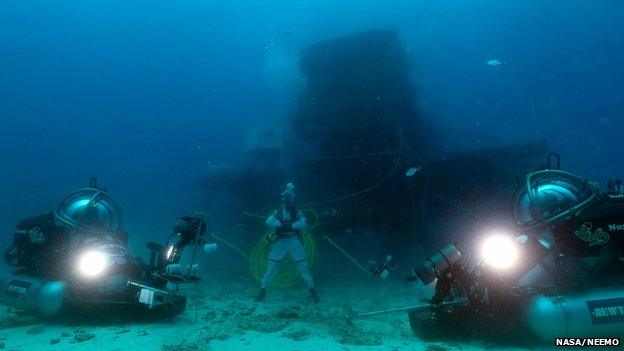
Deep water submersibles will serve as space exploration vehicles
British astronaut Tim Peake is going on a mission to an asteroid... at the bottom of the ocean.
"Major Tim" is joining Nasa's latest Neemo expedition, external to an underwater lab located near Key Largo, Florida.
He will spend 12 days in the Aquarius habitat with three crewmates, testing new tools and techniques that could be used on a real mission to a space rock.
Nasa is planning a huge new rocket to send an advanced manned capsule to an asteroid sometime in the 2020s.
Astronauts have long trained in deep pools to simulate the weightlessness of working in orbit, but the Neemo expeditions take that idea to another level, allowing crews to simulate extended periods off Earth but without actually leaving the planet.
"It's an excellent analogue for what we do in space," explained Major Tim, a former British Army Air Corps helicopter pilot.
"We'll even have a 50-second delay in our communications with Capcom [mission control], and friends and family."
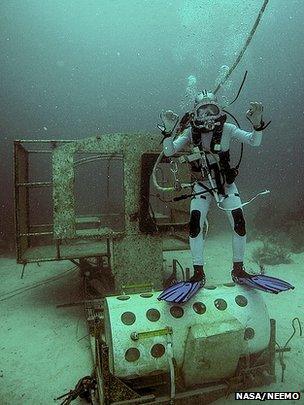
Major Tim has extensive experience as a diver
The delay simulates the time it would take real signals to travel many millions of km across space from an asteroid.
Neemo is an acronym for Nasa Extreme Environment Mission Operations. The US space agency has been running the programme since 2001, using the 20m-deep Aquarius habitat as its test-bed facility.
Major Tim's expedition is the 16th in the programme, and "splashdown" - the moment the crew arrived at Aquarius - occurred at 12:00 EDT (17:00 BST) on Monday.
The crew is led by Nasa astronaut Dottie Metcalf-Lindenburger, and includes Japanese astronaut Kimiya Yui and planetary sciences expert Steve Squyres. Prof Squyres is the principal investigator for the Mars rovers, Opportunity and Spirit.
"It's been just awesome having Steve around," Major Tim told me just before he left.
"Every morning, he opens his laptop to look at the latest pictures from Opportunity on the surface of Mars. So, first thing we get a lecture on Mars from Steve, and then we all get our asteroid briefing for Neemo. It's fantastic."
President Barack Obama has set Nasa the target of landing a crew on an asteroid in 2025, or very soon after.
To get there, the agency is building the Space Launch System, a colossal rocket capable of putting in orbit all the tonnes of equipment that will be needed on such a venture.
The astronaut vehicle itself, known as Orion, is nearing its first test flight.
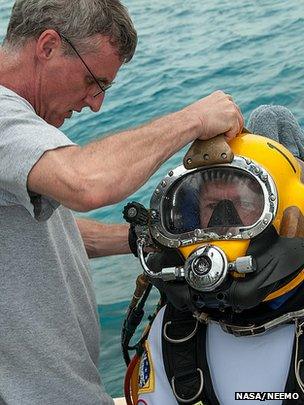
Steve Squyres, left, is the principal investigator for Nasa's Mars rovers
But the crew will require a strategy once they get to the asteroid. As big as many of these space rocks are, they're tiny compared with planets and moons. And that means their gravitational fields will be puny. You cannot simply walk on them. One step and you'd likely lift off into space again.
Crew members would either have to anchor themselves to the asteroid or use some kind of free-floating exploration vehicle that could work as a platform to get the astronauts close to the rock.
"These are some of the big questions we're trying to answer," said Major Tim.
"We will have deep-worker submersibles with us and they will be our space exploration vehicles, with robotic arms and foot plates on them, so we can attach ourselves and explore the asteroid, taking samples - soil samples, rock samples, etc.
"Nasa also wants to know what sort of team compositions are required. Is it better with one SEV [space exploration vehicle] or two SEVs, working in pairs or as individuals? We'll be coming up with all sorts of data that will shape Nasa's asteroid mission."
Major Tim still has to make his first real spaceflight.
He is in a competitive queue at the European Space Agency.
Selected as one of six new astronaut trainees in 2009, he is now waiting for a bunk on the space station to become available to him.
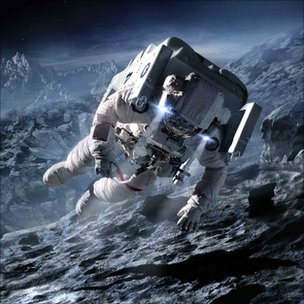
Working around a low-gravity body presents particular problems
This should happen in 2017 or 2019 at the absolute latest.
He will be hoping it happens sooner, of course, and has been following closely the progress of the California company SpaceX, which last month successfully sent an unmanned cargo capsule to the station.
SpaceX intends to put seats and a life-support system in its Dragon vehicle, so it can double up as an astronaut taxi.
The firm would then sell rides to Nasa, which currently has no means of its own to launch astronauts and is very restricted in the number of missions it can run to the orbiting platform.
With up to seven seats available in a Dragon, more opportunities to go into orbit are likely to open up.
"I would jump at the chance to fly in Dragon; I'd be the first to volunteer," said Major Tim.
"The SpaceX mission was a real inspiration, and has shown the way forward. It's time to let the commercial sector look after transport in low-Earth orbit, leaving Nasa free to go and explore beyond the station at places like asteroids."
Follow the Neemo expedition on Facebook, external. Tim Peake will also be tweeting, external.
- Published21 November 2011
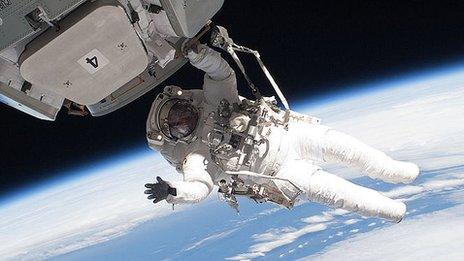
- Published18 February 2011